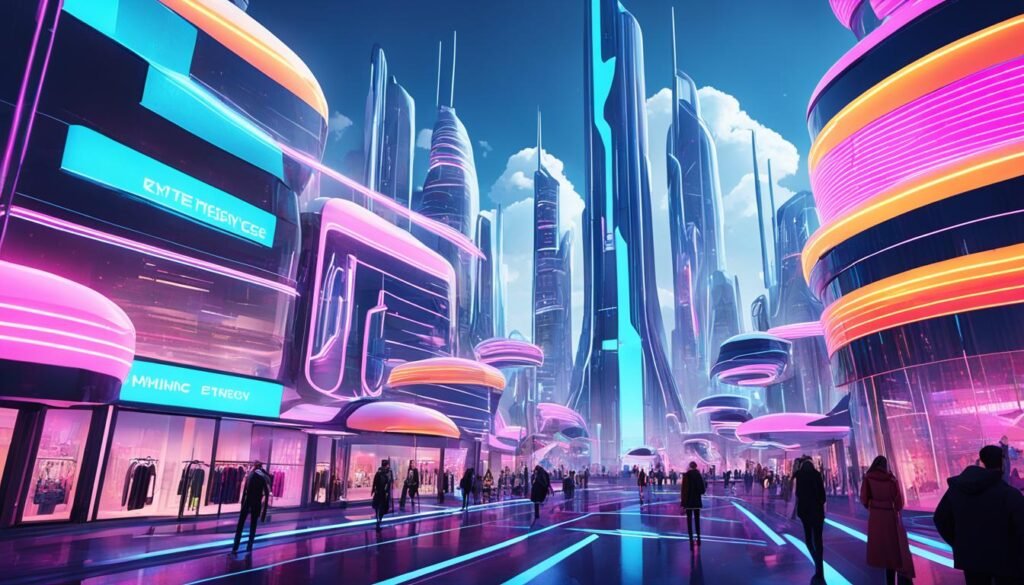A luxury fashion report by Bain & Company estimates the sector will be worth US$368.9 billion by 2024. Customers are focusing more on authenticity, experiences, and deeper connections with their favorite brands. This shift is moving them away from loud logos and extravagant shows of wealth.
Now, discerning buyers prize quality craftsmanship, timeless design, and understated elegance. They look for well-made items that will stay stylish for years. This year, the luxury market is all about lasting value and meaningful connections.
Key Takeaways
- The luxury fashion market is projected to reach $368.9 billion in 2024, driven by consumer demand for authenticity and exclusivity.
- Luxury consumers are moving away from ostentatious displays of wealth, instead seeking out timeless design, premium materials, and exceptional craftsmanship.
- Brands that can align with these evolving consumer preferences, while also leveraging sustainable and innovative practices, will be well-positioned for success in the luxury fashion market.
- The rise of “quiet luxury” and the growing popularity of pre-owned and vintage offerings are key trends shaping the luxury landscape.
- Personalized experiences and immersive digital environments, such as the metaverse, are becoming essential for luxury brands to engage with tech-savvy consumers.
The Rise of Quiet Luxury
There’s a new trend in luxury – the rise of “quiet luxury.” A Bain & Company report says 70% of global luxury shoppers will pay more for durable items. These are things that are timeless and last for years. Luxury brands are changing course. They are focusing more on craftsmanship and using premium materials. This way, they can ensure their products bring quality and last a long time, standing out from short-lived trends.
Timeless Design and Craftsmanship
Quiet luxury is about finding beauty in simple, elegant things. Luxury brands are getting better at making pieces with timeless design. These are items that aren’t just for today but will still look great in years to come. They pay close attention to every detail and use old, trusted methods of craftsmanship. This helps their products be not just pretty but also last a long time.
Premium Materials and Durability
In quiet luxury, the best materials and how long something lasts are key. Luxury shoppers look for things that are beautiful but can also handle daily life. Luxury brands meet this demand by choosing the finest materials. They also use the latest methods to make sure their products last. This way, what they create becomes treasured for a long time.
Hyper-Personalization and Bespoke Experiences
Luxury brands are taking a new approach to win over their clients. They’re using hyper-personalization and bespoke experiences. These methods make sure each customer feels special.
They use big data and high-tech tools to get to know their customers well. This way, they offer things that truly match their likes and needs. This approach can boost customer interest by up to 80%, says McKinsey.
Luxury shopping is getting very personal. You might find custom clothes or special jewelry waiting just for you. Brands use your information to create experiences made just for you. This makes sure their customers really connect with what they offer.
Luxury brands mix technology with a human touch. This creates journeys that are just for you. It not only makes customers stick by their brand more but also shows they’re ahead of the game. They’re ready to surprise their customers with what they dream of.
Sustainable Luxury: Eco-Conscious and Ethical Practices
The interest in eco-friendly and ethical luxury is growing. Big brands are using recycled and eco-friendly materials. By 2025, the pre-owned luxury market may hit $30 billion. People are choosing these options more.
Recycled and Sustainable Materials
Consumers looking for eco-friendly luxury like products from recycled and eco materials. Gucci, Tiffany & Co., and Stella McCartney use such materials. They make designs better and appeal to buyers more.
Responsible Manufacturing Processes
Luxury brands now focus on being less harmful. They use good practices to make their products. They are more energy-efficient, use ethical labor, and have clear supply chains. They want to be about sustainability and being fair to workers.
Pre-Owned and Vintage Offerings
More people are choosing pre-owned luxury for fashion that’s good for the earth. Luxury brands sell vintage and pre-owned items. This new choice is more eco-friendly than buying new.
Experiential Luxury: Exclusive Travels and Events
Consumers today want unique and memorable experiences more than stuff. Luxury brands are answering this by offering exclusive travel packages and private events.
They add bespoke workshops too, where you can learn new crafts from the best.

A study by Eventbrite found 78% of millennials pick experiences over things. This makes experiential luxury a big deal for luxury companies.
These brands help create special memories. They also form strong bonds with consumers who love exclusive travel and going to private events and workshops.
Resale and Luxury Consignment Boom
The luxury consignment market is growing fast. More people are buying and selling second-hand luxury goods. Luxury brands are joining in by starting their own resale websites. They make sure everything is real. They also check items for other websites.
The RealReal website saw a 41% sales increase in 2023. It shows how much people like buying used luxury. Buyers see the value in buying pre-owned goods that are checked and real. Often, they pay much less than the first price. This change is making luxury brands change too. They now offer used goods to meet the demand for sustainable luxury.
The pre-owned market keeps getting bigger. Luxury brands want to be part of this trend. They set up their own resale shops. This lets them check their stuff and connect with buyers who care about the earth.
By doing this, luxury brands are showing they welcome the resale and luxury consignment fever. It’s a big change in the way people buy and sell high-end fashion and items.
Luxury eCommerce: Elevating the Online Experience
Luxury brands are focusing more on luxury ecommerce to keep up with changes. Statista expects 25% of luxury goods sales to move online by 2025. This means brands need to work hard on their digital marketing and luxury ecommerce to improve how people shop online.
Brands that mix online and offline shopping well will stand out. They will create a great experience for shoppers. Connecting the real and digital worlds in luxury digital marketing will help them win in the changing luxury ecommerce market.

Using new tech and focusing on customers can make the online shopping experience better. Think of getting personalized recommendations or trying clothes on virtually. These methods make for a fantastic luxury ecommerce experience. The brands that lead in selling luxury goods online will be top of the class.
Luxury Fashion Trends: High-End Must-Have for 2024
The world of luxury fashion is changing. It’s moving toward “quiet luxury’. This means a focus on timeless design and premium materials. At the same time, there is a big push for hyper-personalized experiences.
Today, consumers want authenticity and exclusivity. They look for deeper connections with the brands they buy from. They have moved on from flashy logos. Now, they prefer a more subtle and elegant style.
To succeed in 2024 and beyond, luxury brands need to meet these new consumer wants. They must also use advanced technology and care for the environment.
The market for high-end apparel is changing a lot. More focus is on designer collections with top-notch quality craftsmanship and durable materials. Or on luxury accessories that are true style icons.
People who love fashion and style are choosing more refined looks. They’re going for luxury fashion that shows sophistication, not just money. By following these trends, brands can be the go-to for customers in 2024.
The Metaverse: A New Frontier for Luxury
The metaverse is quickly becoming key for luxury brands, marking a big change in how they present high-end items and experiences. With a smart entry into this virtual space, luxury brands can expand their reach and outshine others. Names like Gucci, Balenciaga, and Louis Vuitton are taking steps into the luxury metaverse. They’re creating special digital fashion and shopping experiences for those who fancy tech.
Virtual Flagships and Immersive Shopping
Using Virtual Reality (VR), luxury names are making never-before-seen, personal online shopping. This mixes digital and real worlds to boost online sales and make luxury shopping more fun. With VR shopping, shoppers can fully dive into a 3D setting to check out top-quality items, making online shopping a whole new experience.
Digital Fashion Collections
Besides online shopping, luxury brands are also offering exclusive digital fashion lines. These online clothes and accessories let people show their sense of fashion and position in the digital world. These immersive shopping outings blend the real and digital universes, setting new standards for luxury shopping for the next generation of picky buyers.

AI-Powered Personalization and Virtual Assistants
Youth today wants more than ever personalized experiences. Thanks to Artificial Intelligence (AI) and Machine Learning, luxury brands are changing their game online. They use AI to offer shoppers unique experiences, like virtual shopping assistants. These assistants remember your past buys, suggest items that go well with them, and show new collections that suit your taste.
This move online is changing how we see exclusivity. Brands that use AI-driven personalization are seen as leaders in luxury.
With AI and machine learning, luxury companies can really stand out. They can give customers a personalized experience like no other. Think virtual styling and smart product tips. These new tech tools are making the luxury experience richer. And this increases how loyal and exclusive you feel towards a brand.
Blockchain for Authenticity and Transparency
Blockchain luxury is changing the game in the high-end market. It’s making sure what you buy is real and shows how it got to you. Big names like LVMH, Richemont, and Prada are taking this tech seriously. They want their buyers to trust them more.
Thanks to blockchain, luxury brands now provide a digital proof of ownership. This proof also shows a product’s entire journey, from making it to selling it. The aim is to make customers confident their purchase is genuine. It also deepens the connection between the brand and the buyer. Such technology sets a new trust pattern in the luxury world.

Youthful buyers are more and more interested in knowing where their luxury items come from. For them, the blockchain way might soon be the norm. By using this tech, luxury brands can stand out, keep their customers coming back, and stay ahead in the quest for honesty and trust.
Embracing Social Consciousness and Ethical Values
The luxury world is changing. Now, many top brands focus on being socially aware. They choose ethical methods and eco-friendly materials. This change is a response to the new preferences of customers, especially young ones. Teens and young adults care a lot about products that are real, made ethically, and do not harm the earth.
Patagonia and Stella McCartney are at the front of this change. They use materials that are good for the earth and show clearly where their products come from. They are the standard bearers for ethical luxury. By following these examples, luxury brands can make themselves more attractive to careful buyers. They also strengthen their place in the market and help the world be a better place.
The move towards social consciousness and sustainable fashion is key for luxury brands now. They are preparing for a future where customers want real, ethical luxury goods. Today’s shoppers are more aware of how their choices affect the world. By focusing on ethical and green ways, luxury brands are showing they are ready for the future.

Thank you for your sharing. I am worried that I lack creative ideas. It is your article that makes me full of hope. Thank you. But, I have a question, can you help me?